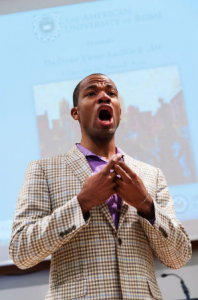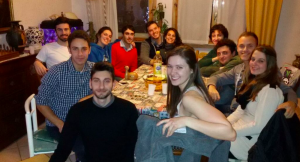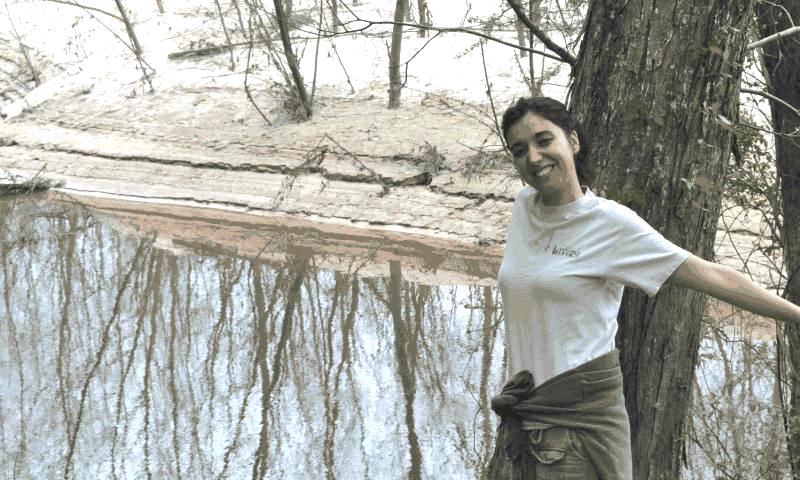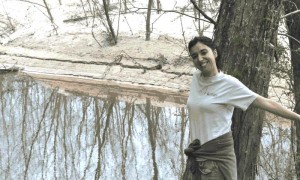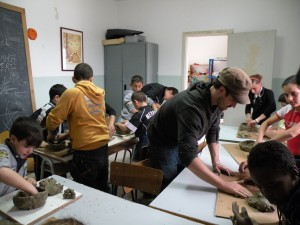 As I sent off an email while preparing my Fulbright application to Italy, I had no idea what kind of reception I would receive from Salvatore Rizzuti, the Sicilian sculptor who would eventually sign on as my principal Fulbright mentor. Nor did I know that I would inhabit a dilapidated parking garage in Palermo as my studio for a year while I was building a floating sculpture out of Sicilian fruit boxes.
As I sent off an email while preparing my Fulbright application to Italy, I had no idea what kind of reception I would receive from Salvatore Rizzuti, the Sicilian sculptor who would eventually sign on as my principal Fulbright mentor. Nor did I know that I would inhabit a dilapidated parking garage in Palermo as my studio for a year while I was building a floating sculpture out of Sicilian fruit boxes.
I did know that many “Odyssey” armchair travelers or geographers have sworn that Odysseus rode the underbelly of a sheep down the slope of a Sicilian beach to escape the Cyclops Polyphemus. I also knew that Sicily sits as a gateway to Europe for many non-Europeans and, as such, receives an influx of immigrants either from or transiting through North Africa.
Before my Fulbright grant, my art practice had developed a distinct social element; I conducted art workshops in refugee camps and orphanages around the world while maintaining a separate studio life, producing ephemeral sculptural events that often took place on bodies of water.
While trying to reconcile the two aspects of my art practice, I arrived in Sicily with three main goals for my Fulbright grant: to study traditional boatbuilding, teach weekly art classes to underprivileged children at a center called Jus Vitae and enact a psycho-geography of Odysseus’s time on the Island of the Sun primarily through building a large-scale floating sculpture that students from my workshops would help me design and which I would build, incorporating techniques from Sicilian boat builders.
Sicily, as a Palermitan told me during my Fulbright year, is the isle of the conquered. He rattled off a long list of conquerors – some of whom included the Romans, Vandals, Byzantines, Americans and now, Mafia. I quickly found the streets of Palermo to be a riot of frenetic activity; cars jumping sidewalks, people jumping cars, a mishmash of culture, history and busy, careening, gesticulating people to be maddeningly energizing. It turned out that the isle of conquered had conquered me.
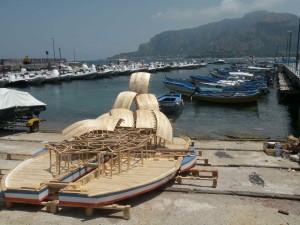 In fact, some new Mediterranean syntax began developing in my brain; hot on the trail of old conquerors and the present inhabitants, one of whom was Pino, a master boat builder, who, for the life of him, couldn’t figure out why I offered to sweep his woodshop every week for free so I could hang around while he repaired fishing boats. By the end of my time in Sicily, I had fused my community art practice with my studio practice by collaborating with the children with whom I volunteered, setting the stage for future projects that combined aesthetic research and volunteerism. I had also managed to float a shotgun shack sculpture down the river Tiber in a sci-fi ode to Huckleberry Finn, spend time at the American Academy in Rome as a visiting artist, and give a series of artist talks sponsored by the U.S. Consulate in Naples and the German Fulbright Commission in Berlin.
In fact, some new Mediterranean syntax began developing in my brain; hot on the trail of old conquerors and the present inhabitants, one of whom was Pino, a master boat builder, who, for the life of him, couldn’t figure out why I offered to sweep his woodshop every week for free so I could hang around while he repaired fishing boats. By the end of my time in Sicily, I had fused my community art practice with my studio practice by collaborating with the children with whom I volunteered, setting the stage for future projects that combined aesthetic research and volunteerism. I had also managed to float a shotgun shack sculpture down the river Tiber in a sci-fi ode to Huckleberry Finn, spend time at the American Academy in Rome as a visiting artist, and give a series of artist talks sponsored by the U.S. Consulate in Naples and the German Fulbright Commission in Berlin.
When I returned to Chicago after my Fulbright grant, I was included in a group show highlighting top emerging artists at the Hyde Park Art Center. With the help of a residency and fellowship, I am currently working on a project to enact a fictitious immigrant landing with sculpture rafts on the city’s Gold Coast, populated by my students from ChiArts, the only public arts high school in the city. In all that I am doing, I find myself talking incessantly about my Fulbright experience and how everyone should apply to be cultural ambassadors by incorporating some sort of volunteerism into their applications. My Fulbright year in Italy was a wellspring that will undoubtedly feed my art practice for years to come. It gave me a framework in which my practice doesn’t solely mine or cannibalize history, philosophy and cultural moments, but also exists in and nurtures my hometown and host communities in sustainable ways.
Top photo: Jeremiah Hulsebos-Spofford, 2009-2010, Italy (in hat), leading an art workshop with children from Jus Vitae in Palermo, Italy
Middle photo:Ecclesiastes Rose: Penelope my martian temple dancer, a boat installed by Jeremiah Hulsebos-Spofford, 2009-2010, Italy, on a dry dock among the fishing boats in Mondelo, Sicily
For more images of my Fulbright work including, Penelope and the Cyclops, please visit www.jspofford.com.
Tips for Applicants:
- If you are currently enrolled at an institution, make the most of working with your Fulbright Program Adviser (FPA) on campus. Even if you are a recent alumnus/na, ask if your alma mater’s FPA might be willing to work with you. Attend Fulbright Information Session and webinars and always ask exhaustive questions whenever it makes sense to do so.
- Contact and network with the Fulbright Alumni Ambassadors. Ask about their projects and their experience with the application process. Look through the titles of successful projects from applicants in your field.
- Choose a country that will stretch your comfort levels and ask: What cultural resources am I pursuing? Why is it imperative that I immerse myself there?
- Incorporate volunteerism into your proposal. The Fulbright Program is an awesome privilege. Service in your host community will open unexpected doors for you personally and professionally.
- Applicants in the Arts and Writing: Take every opportunity that comes your way. Look for residencies, speaking and collaboration opportunities with other artists, and approach local galleries and museums. The Fulbright Program puts you in a unique position to network. Be sure to contact the Fulbright Commission and/or Public Affairs Section at your local U.S. Embassy and make yourself available for artist talks and workshops. If your project is community-based and you need more funding to cover materials, apply for a Federal Assistance Award.
